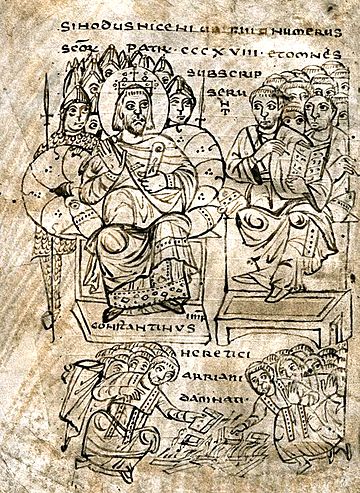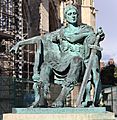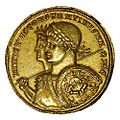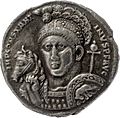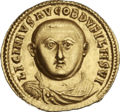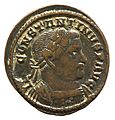Constantine the Great facts for kids
Quick facts for kids Constantine I |
|||||
|---|---|---|---|---|---|
| Emperor of the Roman Empire | |||||
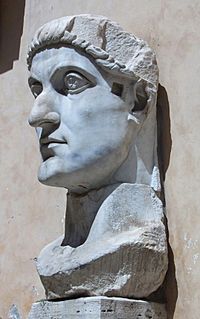
Head of Constantine's colossal statue at the Capitoline Museums
|
|||||
| Reign | 306 - 312 (hailed as Augustus in the West, officially made Caesar by Galerius with Severus as Augustus, by agreement with Maximian, refused relegation to Caesar in 309); 312 - 324 (undisputed Augustus in the West); 324 - 22 May 337 (emperor of the whole empire) |
||||
| Predecessor | Constantius Chlorus | ||||
| Successor | Constantine II, Constantius II and Constans | ||||
| Burial | Constantinople | ||||
| Wives |
|
||||
| Issue | Constantina, Helena, Crispus, Constantine II, Constantius II and Constans | ||||
|
|||||
| Dynasty | Constantinian | ||||
| Father | Constantius Chlorus | ||||
| Mother | Helena | ||||
Constantine I (born February 27, 272 AD – died May 22, 337 AD) was a very powerful general who became an emperor of the Roman Empire. He ruled until his death. He is famous for making the city of Byzantium the new capital of the Roman Empire. This city is now known as Istanbul, Turkey. Constantine renamed it Constantinople, which means "City of Constantine" in Greek.
Before Constantine became emperor, he was fighting for the throne at the Battle of Milvian Bridge. During this battle, he saw a cross in the sky. It had the words in hoc signo vinces, which is Latin for "in this sign you shall conquer." After this, he changed his belief from the god Apollo to Jesus, and he won the battle.
Before Constantine, it was against the law in pagan Rome to be a Christian. Christians were often tortured or killed for their beliefs. But Constantine changed this and protected Christians. He also helped organize the Catholic Church at the First Council of Nicea. Even though he supported Christianity, he was not baptized until just before he died.
Constantine also played a big part in the start of the Orthodox Christian religion. This happened after he moved the center of his rule from Rome to Byzantium.
Contents
Early Life and Rise to Power
Constantine was born in Naissus, which is now Niš, Serbia. His father was Flavius Constantius, a Roman army officer. His father was one of the four rulers of the Tetrarchy, a system where the empire was divided among four leaders. Constantine's mother, Helena, was a Greek woman from a humble background. She was a Christian and is now considered a saint. Many believe she helped her son become a Christian.
Constantine served well under the Roman emperors Diocletian and Galerius. He started his career fighting against the Persians in the eastern parts of the empire. Later, in 305 AD, he was called back to the west to fight alongside his father in Britain. After his father died in 306, Constantine's army declared him augustus (emperor) in Eboracum (York, England). He eventually won several civil wars against other emperors, Maxentius and Licinius. By 324, he became the only ruler of the entire Roman Empire.
Constantine's Reign as Emperor
When Constantine became emperor, he made many changes to make the empire stronger. He reorganized the government, separating the powers of civil (non-military) and military leaders. To fight rising prices, he created a new gold coin called the solidus. This coin became very important and was used for over a thousand years in the Byzantine Empire and Europe.
He also changed the Roman army. It now had fast-moving units called comitatenses and border defense troops called limitanei. These new armies could fight threats from inside the empire and stop barbarian invasions. Constantine led successful campaigns against tribes like the Franks, Alemanni, Goths, and Sarmatians along the Roman borders. He also brought Roman citizens back to areas that had been left empty during the Crisis of the Third Century.
Constantine's time as emperor was a major turning point in Roman history. It marked the shift from classical antiquity to the Middle Ages. He built a new imperial home in the city of Byzantium and called it New Rome. Later, it was renamed Constantinople after himself. This city became the capital of the empire for more than a thousand years. The later Eastern Roman Empire is often called the Byzantine Empire today.
Constantine lived much of his life as a pagan and later as a catechumen (someone learning about Christianity). However, he began to favor Christianity around 312 AD. He eventually became a Christian and was baptized near the end of his life. He played a key role in the Edict of Milan in 313. This edict made Christianity legal and allowed people to practice their faith freely in the Roman Empire.
In 325, he called the First Council of Nicaea. This meeting produced the Nicene Creed, an important statement of Christian belief. He also ordered the building of the Church of the Holy Sepulchre in Jerusalem. This church was built where Jesus' tomb was believed to be and became the holiest place in Christendom. Constantine is often called the "First Christian Emperor." He did a lot to make Christianity a more accepted part of Roman culture. He is honored as a saint in Eastern Christianity.
Constantine's Religious Policies
Constantine was the first emperor to stop the persecution of Christians. He made Christianity legal, along with all other religions in the Roman Empire. In February 313, he met with Licinius in Milan. Together, they created the Edict of Milan. This edict stated that Christians could follow their faith without being punished. It also returned Church property that had been taken away during earlier persecutions. The edict protected all religions from harm, not just Christianity. It allowed anyone to worship any god they chose.
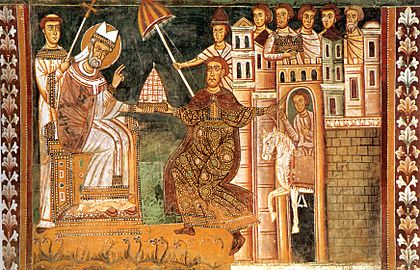
Christian writers say that Constantine was over 40 when he declared himself a Christian. He said his successes were thanks to the Christian God. Even though he said he was a Christian, he waited to be baptized until he was dying. He believed that baptism would wash away any sins he committed while being emperor. He gave money to the Church and built many churches, like the Church of the Holy Sepulchre and Old St. Peter's Basilica. He also gave special benefits to Christian leaders, such as not having to pay certain taxes. He promoted Christians to important government jobs.
Constantine also built the Old St. Peter's Basilica on top of St. Peter's resting place. He went to great lengths to do this, even changing the design of the church to fit the hill where St. Peter was buried. The building of this church took over 30 years.
Even though he supported Christianity, Constantine might not have only supported Christians. A triumphal arch was built in 315 to celebrate his victory at the Battle of the Milvian Bridge. This arch had images of the goddess Victoria. Sacrifices were also made to pagan gods like Apollo, Diana, and Hercules when the arch was dedicated. There are no Christian symbols on this arch.
In 321, Constantine made a law that "venerable Sunday" should be a day of rest for everyone. In 323, he banned Christians from taking part in state sacrifices to pagan gods. After a while, pagan gods disappeared from his coins. Instead, Christian symbols like the chi rho appeared on his coins and on his military banner (labarum).
Constantine also made some new laws about Jewish people. Some of these laws were not favorable to Jews, but they were not harsher than those made by earlier emperors. For example, it became illegal for Jews to try to convert others to Judaism. It was also illegal for them to attack Jews who had converted to Christianity. They were not allowed to own Christian slaves. However, Jewish religious leaders were given the same tax benefits as Christian clergy.
Constantine's Lasting Impact
Constantine brought the Roman Empire back together under one emperor. He won important battles against the Franks and Alamanni between 306 and 308. He defeated the Franks again in 313–314, the Goths in 332, and the Sarmatians in 334. By 336, he had taken back most of the province of Dacia, which had been lost earlier. When he died, he was planning a large military trip to stop attacks from the Persian Empire in the east.
In terms of culture, Constantine brought back the fashion of being clean-shaven for emperors. Before him, emperors like Hadrian had worn beards. This new Roman imperial fashion lasted until the 7th century.
Constantine changed how emperors passed on their power. Instead of the old system, he left the empire to his sons and other family members of the Constantinian dynasty. His good reputation continued through his children's lives and for many centuries after his rule.
Later, in the Holy Roman Empire, Constantine was seen as a very important figure. In the Byzantine Empire, it was a great honor for an emperor to be called a "new Constantine." Ten emperors after him took his name. Even Charlemagne used symbols and styles from Constantine's time to show that he was Constantine's successor. Many royal families and important people throughout history claimed to be related to Constantine.
Today, the Niš Constantine the Great Airport in Serbia is named after him. A memorial was built in Niš in his honor in 2012. In 2013, an event was held in Niš to celebrate the "Commemoration of the Edict of Milan." The Orthodox Church considers Constantine a saint. His feast day is on May 21, and they call him isapostolos, meaning "equal of the Apostles."
Images for kids
-
Remains of the luxurious residence palace of Mediana, built by Constantine I near his birth town of Naissus
-
Porphyry bust of the Emperor Galerius
-
Modern bronze statue of Constantine I in York, England, near where he was declared Augustus in 306
-
Public baths (thermae) built in Trier by Constantine. They were over 100 meters wide and 200 meters long, able to serve thousands of people at once.
-
Dresden bust of the Emperor Maxentius, who was defeated by Constantine at the Battle of the Milvian Bridge
-
A gold solidus coin of "Unconquered Constantine" with the god Sol Invictus behind him, made in 313 AD.
-
Battle of Constantine and Maxentius (a detail from a fresco by Giulio Romano in the Raphael Rooms in the Vatican), a copy from around 1650.
-
The Milvian Bridge (Ponte Milvio) over the River Tiber, north of Rome, where Constantine and Maxentius fought.
-
Silver medallion from 315; Constantine with a chi-rho symbol as the crest of his helmet
-
Constantine the Great by Philip Jackson, a statue unveiled in York in 1998. York Minster is in the background.
See also
 In Spanish: Constantino I para niños
In Spanish: Constantino I para niños


